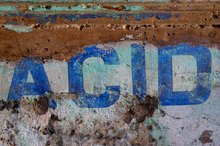What Kind of Acid Can Eat Through Metal?
There are numerous hazardous materials that can result in bodily injury, property damage and, in severe cases, death if not handled properly. One type of such materials are acids. Corrosive acids are designated by the Workplace Hazardous Materials Information System, or WHMIS, as Class-E materials. These acids are capable of destroying the skin and also eating through metal. Several acids make up this class.
Nitric Acid
Nitric acid is a colorless, corrosive liquid produced by the oxidation of ammonia over a platinum catalyst at high temperatures 3. And in addition to presenting human health hazards, such as skin and eye injury, it's an acid also known to melt through common metals, with the exception of gold and platinum. As it reacts with metal, the product that results is dependent upon the concentration of the acid used.
Hydrofluoric Acid
Hazards of Acids & Bases
Learn More
Hydrofluoric acid is a corrosive acid that is colorless and features a strong, unpleasant odor. It's typically used for things like mineral digestion, etching and surface cleaning. The health hazards are based on the type of exposure and the concentration, but it is known to destroy skin tissue and eat through bone. The acid doesn't stop there, it can also eat through metal. For these reasons, the acid must be stored in chemically appropriate containers.
- Hydrofluoric acid is a corrosive acid that is colorless and features a strong, unpleasant odor.
- For these reasons, the acid must be stored in chemically appropriate containers.
Sulfuric Acid
Sulfuric acid in concentration between 10 and 90 percent is known to be particularly corrosive 2. In fact, according to Tantaline, metals such as titanium and Hastelloy will show rapid corrosion at such concentrations and at temperatures below 100 degrees Celcius 2. Only a few exotic metals, such as Zirconium and Tantalum materials can be applied above the acid's boiling point and not show signs of corrosion.
Sodium Hydroxide
Acids Found in Apple Juice
Learn More
Sodium hydroxide, also known as caustic soda and lye, has no color and can exist in either a liquid or solid state. It's one of the most common chemicals found in industry today and is used to make things like plastics and textiles. Sodium hydroxide has the potential to burn or eat away any part of the body that it comes into contact with. It also has the potential to burn through certain metals.
- Sodium hydroxide, also known as caustic soda and lye, has no color and can exist in either a liquid or solid state.









